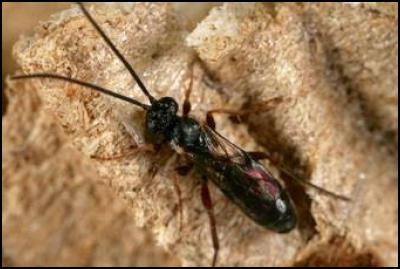Fighting wasps with wasps
2 August 2016
Fighting wasps with wasps

A parasitic wasp is the latest weapon scientists are investigating in the war against wasps.
Landcare Research is exploring possible biocontrol agents, including a mite, to help control German and common wasps which cost the country’s primary industries around $130 million each year.
The most recent addition to the line-up is Sphecophaga, a species of parasitic wasp whose larvae feed off their host, eventually killing it.
The species was tried as a biocontrol agent against wasps in New Zealand starting in the 1980s, but so far has only established in a few locations.
However, recent research suggests this could be because the parasitic wasps were from the wrong region - sourced from Switzerland, Israel and the United States. Victoria University recently discovered New Zealand’s dominate wasp species originate from the UK.
Landcare Research biocontrol scientist Dr Ronny Groenteman said this information was “a key piece of the puzzle”.
Interactions between hosts and parasites are complex, and even more so when the host is a colony-forming insect as they rely heavily on chemical communication within the colony. These chemical signals serve as their language, she said.
“In order for Sphecophaga to go undetected in the nest, they must ‘speak’ the correct language, or dialect, in order to fool their hosts. Otherwise, wasps are so hygienic that they will rapidly remove any foreign intruders they detect.”
In light of this new information, Landcare Research scientist Dr Bob Brown is going to the UK in September to collect and bring backSphecophaga to see if they can go undetected.
Sphecophaga females enter the wasp nest and lay their eggs on young just before they begin to pupate. The Sphecophaga larvae then feed on the wasp pupae killing them, he said.
The research is being funded by a Ministry for Primary Industries’ Sustainable Farming Fund (SFF) grant to the Vespula Biocontrol Action Group.
Dr Brown and Dr Groenteman are optimistic about the parasitic wasp but cautioned often multiple agents were needed to suppress a pest.
Dr Brown has also been investigating the biocontrol potential of a mite, Pneumolaelaps niutirani, he found on wasp nests in 2011.
Promisingly, nests where the mite was found were 50 to 70 per cent smaller than uninfested nests.
However,
after observing the mites feeding behaviour under the
microscope, Dr Brown suspects the smaller wasp colony size
was most likely caused by a disease transmitted by the
mites.
“When the mites were first introduced to an
uninfested nest they went straight to the wasp larvae that
were regurgitating food. That’s what they’re feeding on.
So they’re not directly parasitising the wasps but most
likely vectoring a disease,” he said.
While examining
infested nests this year he also found many were not as
small as in previous years.
“This year there wasn’t
the same correlation, many of the infested nests appeared
healthy. There seems to be something more going on with the
interactions than originally thought. We think that it is
most likely some of the mites are carrying a pathogen or
disease while others aren’t.”
Dr Groenteman said
while the mite didn’t appear a “classical biocontrol
agent” - able to be self-sustaining without human input -
it could still assist in controlling wasps.
“The mite might work better if we load it with wasp-specific pathogens and distribute similar to how we would bait and poison,” she said.
New Zealand’s Biological Heritage National Science Challenge is currently funding the investigation into the mite-pathogen option, with continued support from the SFF grant.
Other potential wasp biocontrol agents Landcare Research has identified and plan to explore include a parasitic hoverfly, Vollucella inanis, and a parasitic fly, Leopoldius coronatus. The Vespula Biocontrol Action Group is currently applying for a new SFF grant to work on these agents and is seeking co-funding support.
ENDS


 Raise Communications: NZ Careers Expo Kicks Off National Tour Amid Record Unemployment
Raise Communications: NZ Careers Expo Kicks Off National Tour Amid Record Unemployment Hugh Grant: How To Build Confidence In The Data You Collect
Hugh Grant: How To Build Confidence In The Data You Collect Tourism Industry Aotearoa: TRENZ 2026 Set To Rediscover Auckland As It Farewells Rotorua - The Birthplace Of Tourism
Tourism Industry Aotearoa: TRENZ 2026 Set To Rediscover Auckland As It Farewells Rotorua - The Birthplace Of Tourism NIWA: Students Representing New Zealand At The ‘Olympics Of Science Fairs’ Forging Pathway For International Recognition
NIWA: Students Representing New Zealand At The ‘Olympics Of Science Fairs’ Forging Pathway For International Recognition Coalition to End Big Dairy: Activists Protest NZ National Dairy Industry Awards Again
Coalition to End Big Dairy: Activists Protest NZ National Dairy Industry Awards Again Infoblox: Dancing With Scammers - The Telegram Tango Investigation
Infoblox: Dancing With Scammers - The Telegram Tango Investigation